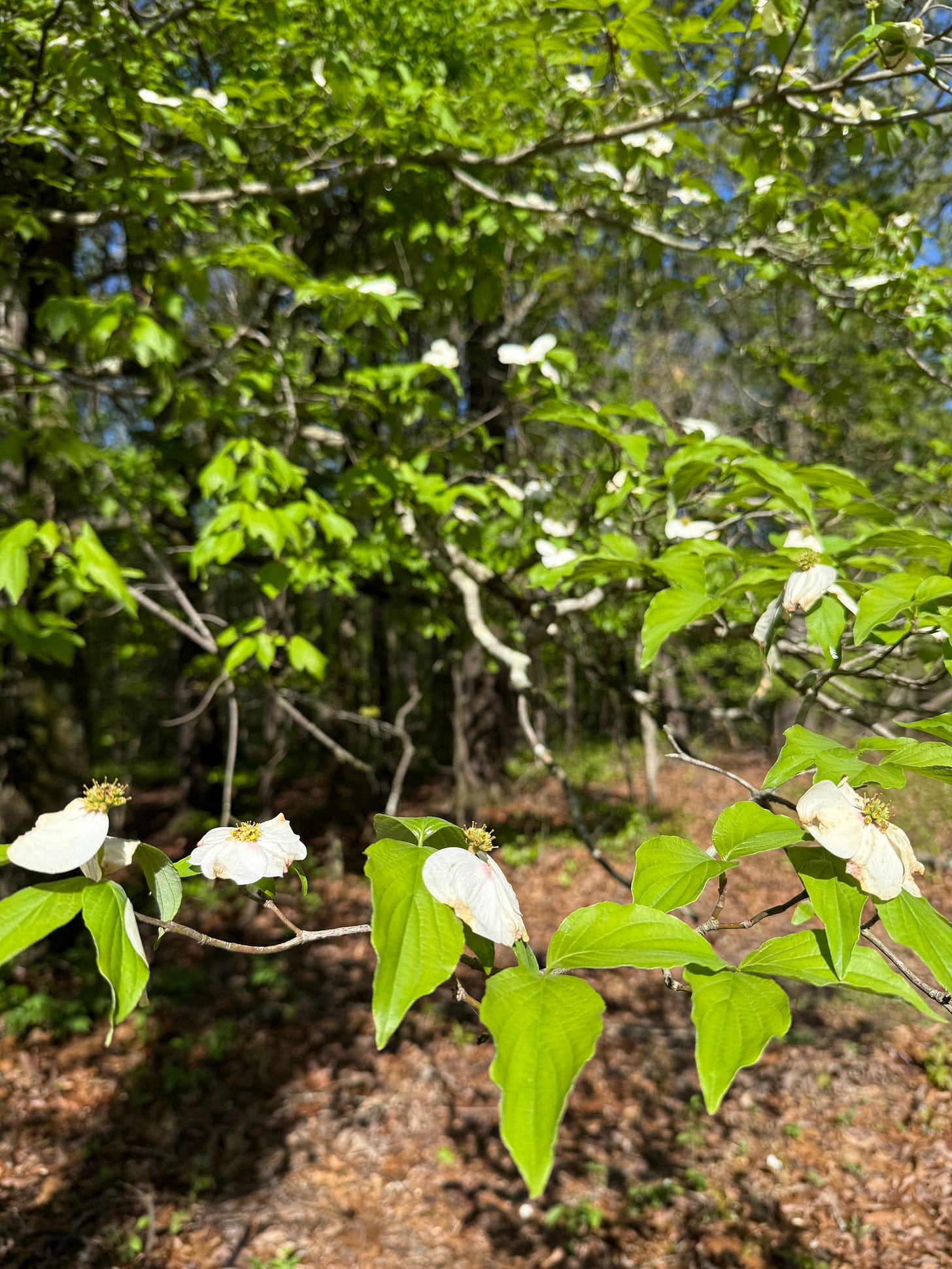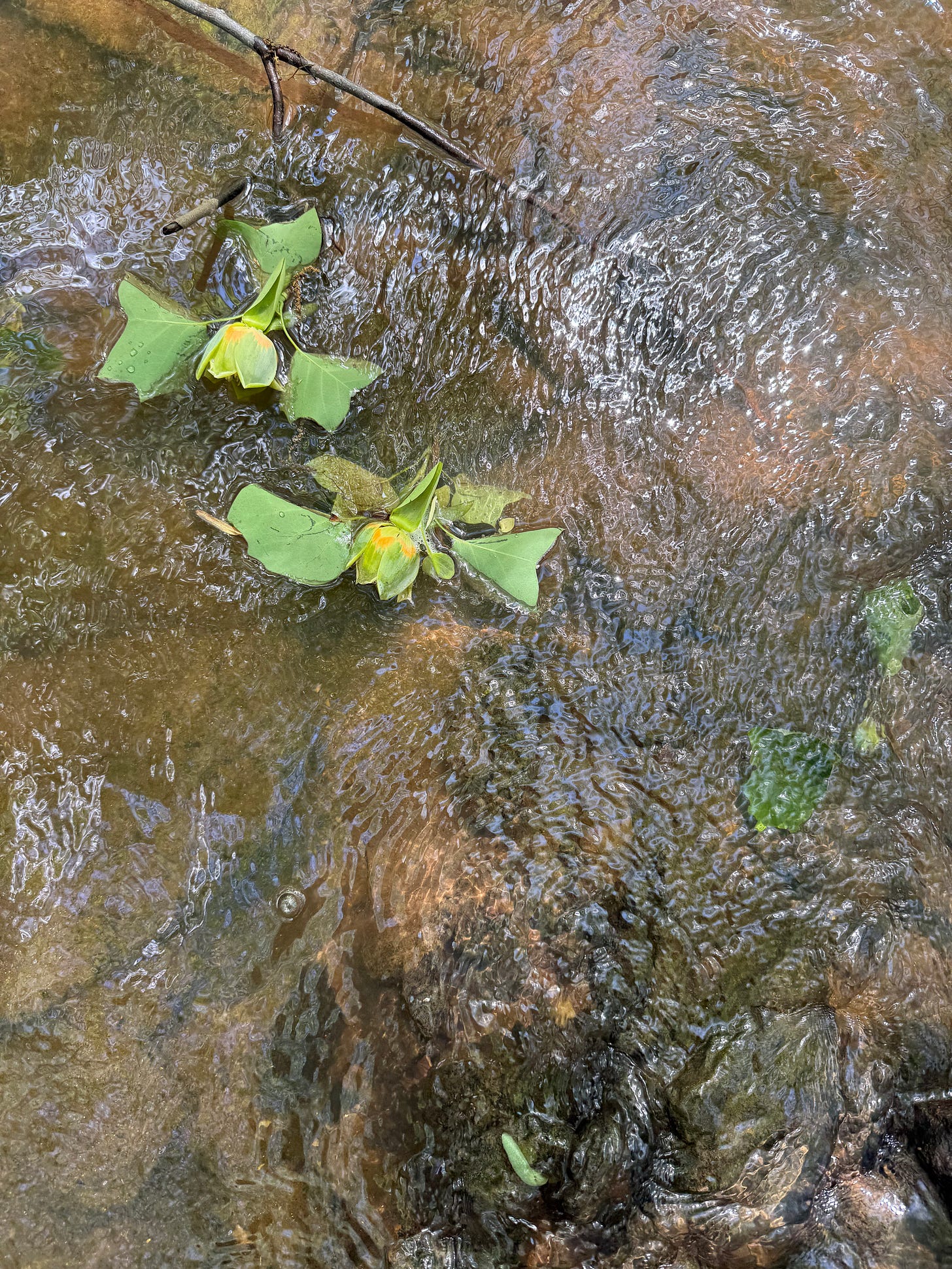Tulip-poplar winter because the dogwood flowers were browning and tired, mostly shattered, but the poplar blossoms had just begun to fall to the ground. I picked up a fallen one in the woods, walking with my friend Allyssa, and she asked, “Where are they?,” looking around. I pointed high above our heads to the tip-top of the poplar canopy. You can’t see them from the ground. I handed the blossom to her. Cupping it, she called it a psychedelic magnolia, which was perfect, I told her, because they’re in the magnolia family, “poplar” being a misleading common name. And now I will forever think of them as psychedelic magnolias, the Liriodendrons.
When I bent to fish out two blossoms that I’d watched bobbing in an eddy of the creek for a day, not moving, I found they were attached to a pencil-thin branch, which I hadn’t noticed because it was mostly submerged. Two more tightly clasped buds, blue-tinged and veinous, remained on the branch—it had been knocked down before all the flowers could open. Tulip-poplar winter because a cold spell moved in earlier last week after a rainburst and wind-gusts. Chilly mornings all week, in a jacket with dew glistening on the sudden-green fields and the frogs and crickets gone quiet. Sweaters and sunshine in the afternoons and more passing rain showers and wool socks. Open windows at night so the cool, cool air could settle into the rooms of the house where I dream.
Back home in Appalachia, four hours north of here, my birthday often fell in the middle of dogwood winter, and there were a couple years we got snow on April 11th, a white blanket over the greening fields to compliment the dogwood blossoms. Memories layer the seasons, along with other places. My birthday fell on what was blackberry winter in South Georgia, four hours south of here, three years ago. Too cold even to camp, as we’d planned, and a friend put us up in her house of cold and drafty longleaf-pine walls, under piles of quilts, and we woke to a warm breakfast and cradled steaming mugs of tea, then later paddled through a cypress swamp with the sun high, the new leaves of the Ogeechee tupelos a faint lime-green, and light filtering through the cypresses, casting shadows.
This year a friend came over and we cut the tops from my nettles and gathered violet leaves, chickweed (gone leggy now, whereas it was leafy last month), and cleavers, and cooked a spring-greens pie. At the farmers market that morning the booths were flush with frilly frisée, butter lettuce, arugula, and collards but had already sold out of all the first precious sweet strawberries of the season. So we got them store-bought from Florida and made a strawberry cake with fresh mint from the garden and wild sorrel on top. We picnicked on the creek bank at the golden hour, the creek’s song soft and the woodpecker’s drumming echoing through the woods.
Allyssa said the light was “getting” her, and I knew what she meant. This light gets me all the time, I said. But the air, cool on the tip of my nose, cool floors in my house, cool tulip-poplar blossoms in my hands, that’s what most got me this week, turned it into a whole season unto itself. A feeling a little psychedelic, like time going tenderly in reverse even as I wheel forward into another lap around the sun.
+
“Live in each season as it passes; breathe the air, drink the drink, taste the fruit, and resign yourself to the influences of each.”
— Thoreau in his journal, August 23, 1853
Each week, I share some of my passing seasons from here in the Georgia Piedmont, where I currently live. At the end of each post, I invite you to share from your own corner of the earth. You can join the SPELLS community in this grounding practice throughout the year, an experiment in a collective phenology.
Phenology is the study of how life is influenced by the seasons. The word is derived from the Greek phainein, meaning to "bring to light,” “cause to appear,” or “show." What does each season bring to light? As ecological writers, how can we recognize the connection between our inner and outer worlds? Even as our seasons shift with a changing climate, how can we stay rooted and cultivate a more intimate relationship with the place we live?
I’m interested to deepen both our ecological knowledges and our feeling-sense of being alive in the sixth mass extinction together. This is both a writing practice and an ecological practice that I invite you into. Perhaps you will decide to learn the birds in your backyard or begin to identify the trees around you, or maybe you’ll become a bug enthusiast and take careful note of their seasonal cycles. But you will also begin to set pen to paper each week and write something about what’s happening in the world around you.
As you’ll see from my own sharing, I am liberally creative with my personal phenologies, sometimes documenting what I’m reading, or music I heard, or something else that happened, and I also try to follow the beautiful earthly flux of my feelings, to notice how my internal states are in a dance with the sky, the weather, the hummingbirds’ return. My intention is to immerse myself in each season’s passing in a particular place, to notice unfurlings and blossomings and storms and rainfall patterns and migrations. Not in a scientific way but as a writer. (You’ll notice that I do like to geek on plants and trees, though.) My intention, really, is to be alive in these times.
I’m inviting you to be alive with me. Thank you to all of you who share your own phenologies each week in the comments! No need to be perfect or polished, this is a rough and wild practice of presence without much revision. I am enriched by hearing from you and believe we can fertilize one another’s presence this way, even from afar.










First, that cake!!! And thank you for another amazing post.
I missed posting last week, so here is my combined list. Hairy bittercress, spring beauties and bluets, a brown thrasher (a bird I never knew was here with a name that sounds more roller derby than beautiful song bird) in black cherry tree, northern spicebush blooming chartreuse and frazzled, first rainy walk that was warm enough to be comfortable, tiny leaves on black cherry trees, sweet cherry blooming, British soldier lichen, ground ivy blooming, hairy wood mint, teasel greens, dock, cut leaf toothwort buds, red dead nettle, barn swallows returned and made good use of all this mud building a new nest, blue bird on nest, dandelion pollen stuffed corbiculae on honeybees, tadpoles, dogwood flowers getting more serious about opening, purple johnny jump ups, a few white, and one yellow, skunk cabbage wide open, tips of a few inner leaves tinged blood red, lilacs small and tight, grape hyacinths.
Grateful always for the gifts you give this world 🌱🌸🦫